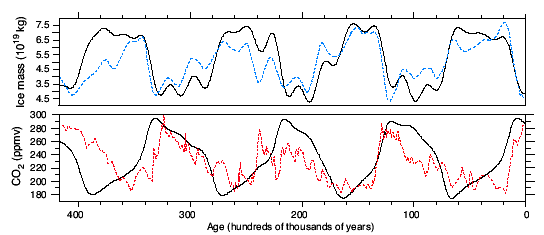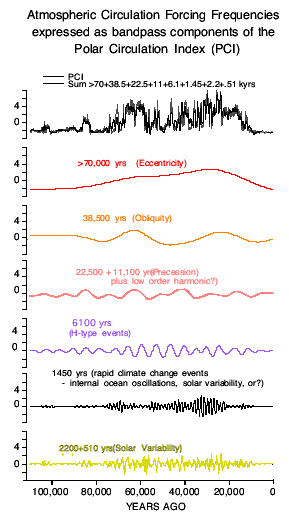Earth's climate is controlled by multiple factors and these
factors can change in relative importance over time.
(1) Changing concentrations of greenhouse gases (such as CO2, CH4, water vapor) can reach critical levels in the atmosphere and in so doing can cause dramatic changes in the climate system. An instability in the carbon cycle could give rise to an auto-oscillation of the global climate system on a near-100,000 year time scale.
Large magnitude changes in climate conditions on Earth have occurred over the last few million years. In particular, there were major transitions near 2.5 million years ago, when significant northern hemisphere glaciaton started, and near 900,000 years ago when a high-amplitude near-100,000 year period oscillation began. While no widely accepted explanation for these changes presently exists, we conclude from an inspection of available evidence for paleoclimate reconstruction that:
- The main variations of planetary ice mass do not represent a linear response to the known orbitally-induced radiative forcing, having a temporal spectrum that is much different than that of the forcing.
- These variations are not in quasi-static "equilibrium" with the known forcing, and therefore cannot be determined without taking the non-steady rates of change of ice into account.
- Although it is possible that the orbital external forcing may be a necessary condition for the observed ice variations, they cannot be a sufficient condition.

(2) Changes in climate over the last 100,000 years have been produced by several different climate forcing agents.

The PCI (Polar Circulation Index), top of figure, is a record developed from the analysis of GISP2 major chemistry (sodium, magnesium, calcium, potassium, ammonium, chloride, sulfate, and nitrate - together these represent >95% of all of the chemicals dissolved in the atmosphere). The PCI describes the dynamics of the polar atmosphere that envelops the source regions for chemicals transported to Greenland during the last glacial period (11,500 to 110,000 years ago). Thus the PCI provides a relative measure of the average size and intensity of polar atmospheric circulation. In general terms, PCI values increase (e.g., more continental dusts and marine contributions) during colder portions of the glacial period (stadials) and decrease during warmer periods (interstadials and interglacials).
The PCI record is contrasted with the sum of the cycles estimated from this series. The sum represents ~90% of the signal behavior in the original PCI series demonstrating that the original record is almost approximated by these cycles and that the record is comprised of a great deal of predictability. Statistical tests demonstrate that these cycles are more than 99% likely.
Major cycles derived from the PCI series include those with periodicities close to Earth's orbital cycles of eccentricity, obliquity and precession. Other cycles are believed to be related to ice sheet dynamics, ocean circulation and solar variability.
The 6100 year cycle approximates the timing of Heinrich events (massive discharges of icebergs that carried glacially carved debris into the ocean. The 1450 year cycle approximates the timing of the many of the rapid climate change events in the GISP2 record.
Selected References:
Maasch, K. A. and B. Saltzman, 1990, A low-order dynamical model of global climatic variability over the full Pleistocene. J. Geophys. Res., 95, 1955-1963.
Mayewski, P.A., Meeker, L.D., Twickler, M.S., Whitlow, S.I., Yang, Q., Lyons,W.B. and Prentice, M., 1997, Major features and forcing of high latitude northern hemisphere atmospheric circulation over the last110,000 years, J. Geophys. Res., 102, C12, 26,345-26,366.
Saltzman, B., Maasch, K.A., and Verbitsky, M. Ya., 1993, Possible effects of anthropogenically increased CO2 on the dynamics of climate: Implications for ice age cycles. Geophys. Res. Lett., 20, 1051-1054. Saltzman, B., and K. A. Maasch, 1991, A first-order global model of late Cenozoic climatic change.Clim. Dyn., 5, 201-210.
Saltzman, B. and K. A. Maasch, 1988, Carbon cycle instability as a cause of the late Pleistocene ice age oscillations: modeling the asymmetric response. Global Biogeochemical Cycles, 2, 177--185.

